
March 1956 to September 1973
British European Airways Corporation (BEA)
G-AOJC - c/n 152 - a V.802 series Viscount
United Kingdom registered
6 March 1956
Re-registered to British European Airways Corporation (BEA) from G-AOHC.
Although the reason for this registration change is not known, it is likely to have been done to avoid conflict operationally with V.701 Viscount G-ANHC (C/N 63).
Production Aircraft No. 3 - the 3rd production V.800 series Viscount built,
was the 3rd V.800 Viscount fuselage assembled at Hurn, Bournemouth, Hampshire, England,
and the 3rd V.800 Viscount assembled at Weybridge, Surrey, England.
Production Order No. F03/802. Sales Order No. F03/63B. Stock Order No. F03/26B.
21 April 1956
Fuselage assembly commenced at Hurn Airport, Bournemouth, Hampshire, England.
June 1956
Fuselage transported by road from Hurn Airport, Bournemouth, Hampshire, England to Weybridge, Surrey, England.
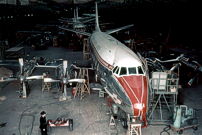
Erecting Shop 'E' at Weybridge, Surrey, England
30 June 1956
Fuselage to Erecting Shop 'E' at Weybridge, Surrey, England.
7 November 1956
First flight from Brooklands Airfield, Weybridge, Surrey, England.
It landed at Wisley Airfield, Surrey, England for fitting out and test flying.
15 January 1957
Certificate of Airworthiness (CofA) issued.
19 January 1957
Delivered to British European Airways (BEA) named as 'R M A Robert O’Hara Burke'.
20 January 1957
Noted at Blackbushe Airport, Hampshire, England due to a London Airport (Heathrow) weather diversion.
6 February 1957
Noted at Blackbushe Airport, Hampshire, England due to a London Airport (Heathrow) weather diversion.
6 December 1957
Noted at Blackbushe Airport, Hampshire, England due to a London Airport (Heathrow) weather diversion.
12 November 1958
Noted at Gatwick Airport, Surrey, England due a London Airport (Heathrow) weather diversion.
24 December 1958
Noted at Gatwick Airport, Surrey, England due to a London Airport (Heathrow) weather diversion.
February 1959
Noted at Teversham Airport, Cambridge, England awaiting overhaul with Marshall's.
March 1959
A new BEA 'Red Square' livery was adopted and aircraft were repainted during the early 1960s when they next went in for overhaul.
Sadly, after repainting, the aircraft no longer carried a name including the nameplate on the forward cabin bulkhead.
20 March 1959
Ferried to Teversham Airport, Cambridge, England for modifications by Marshall's.
31 March 1959
BEA annual report quotes a total flying time of 4,310 hours.
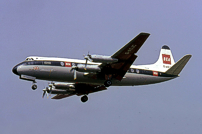
BEA
‘Red Square‘ livery
30 September 1959
Noted at Blackbushe Airport, Hampshire, England due to a London Airport (Heathrow) weather diversion.
12 November 1959
Noted at Gatwick Airport, Surrey, England due to a London Airport (Heathrow) weather diversion.
1 December 1959
Noted at Gatwick Airport, Surrey, England due to a London Airport (Heathrow) weather diversion.
26 February 1960
Noted at Blackbushe Airport, Hampshire, England due to a London Airport (Heathrow) weather diversion.
17 September 1960
Nose undercarriage collapsed on landing at Jersey Airport, Channel Islands.
Repaired locally and returned to service.
9 December 1960
Noted at Gatwick Airport, Surrey, England due to a London Airport (Heathrow) weather diversion.
31 March 1961
BEA annual report quotes a total flying time of 8,890 hours.
This was the highest total hours in that year for the BEA Viscount V.802/806 fleet.
31 March 1962
BEA annual report quotes a total flying time of 11,229 hours.
This was again the highest total hours in that year for the BEA Viscount V.802/806 fleet.
4 December 1962
Noted at Gatwick Airport, Surrey, England due to a London Airport (Heathrow) weather diversion.
9 September 1963
The nose undercarriage collapsed on landing at Cointrin Airport, Geneva, Switzerland due to a fractured component.
The aircraft had made a precautionary flapless landing here due to a loose flap beam fairing being observed during the flight.
There were no reported injuries to the 30 passengers and 4 crew on board.
Repaired locally and returned to service.
21 January 1964
Noted at Gatwick Airport, Surrey, England due to a London Airport (Heathrow) weather diversion.
5 July 1965
Noted at Leeds / Bradford Airport, Yeadon, Yorkshire, England operating UK services on behalf of BKS Air Transport Ltd.
31 March 1968
BEA annual report quotes a total flying time of 24,666 hours.
This was again the highest total hours in that year for the BEA Viscount V.802/806 fleet.
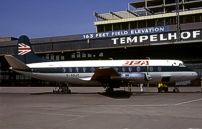
BEA
‘Flying Union Jack‘ livery
circa 1968
A new BEA ‘Flying Union Jack‘ livery was adopted and most aircraft were repainted when they went in for major overhaul, which took some of them into the early 1970s before this was accomplished.
20 December 1969
Noted at Gatwick Airport, Surrey, England due to a Heathrow Airport weather diversion.
6 November 1970
Noted at Luqa Airport, Malta with 'Malta' replacing the BEA red squares on the cheatline.
1971
The Chairman of BEA, Henry Marking, split the airline into several divisions as part of his ‘profit centre’ philosophy, with each division being responsible for it’s own financial performance. As a result the Viscount V.802 fleet was split into two.
The ‘Scottish Airways' division had eight Viscounts based at Abbotsinch, Glasgow, Scotland. The ‘Channel Islands' division had twelve Viscounts with four being operated from Jersey Airport, five from Birmingham International Airport, West Midlands, England and one from Guernsey Airport, Channel Islands. The remaining two aircraft of the ‘Channel Islands' fleet were used on a charter to GB Airways to operate the Gibraltar to Tangier, Morocco service, and to act as operational spares.
All aircraft had either ‘Scottish Airways’ or ‘Channel Islands’ titling applied to the upper fuselage. In practice to maintain operational flexibility there was considerable mixing of the aircraft. On one occasion in August 1971 two of the ‘Channel Islands’ Viscounts were on the ramp together at Sumburgh Airport, Shetland Islands, some 750 miles (1,250 km) from the Channel Islands.
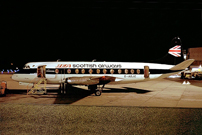
BEA
‘Scottish Airways‘ livery
G-AOJC was allocated to the ‘Scottish Airways’ division and had titles applied alongside ‘BEA’ titling on the upper fuselage.
31 March 1972
BEA annual report quotes a total flying time of 31,818 hours.
This was the last year that individual aircraft flying hours were reported.
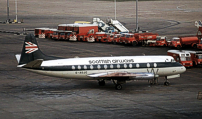
‘Scottish Airways‘ livery
31 July 1973
Transferred to British Airways (BA) due to a corporate merger.
 FURTHER READING: Books about BEA - British European Airways FURTHER READING: Books about BEA - British European Airways
|



